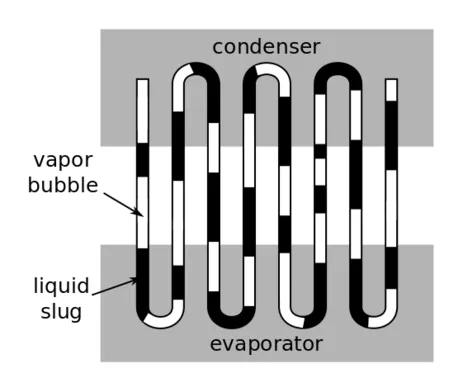Origin and Mechanism of Instability in Pulsating Heat Pipes
by Felix Schily and Wolfgang Polifke
What is a Pulsating Heat Pipe?
A Pulsating Heat Pipe (PHP, also Oscillating Heat Pipe OHP) is a wound tube containing a working fluid in two-phase equilibrium. The tube has a small diameter (e.g. 2mm), in order to ensure a sufficiently dominant influence of the surface tension forces, that the working fluid forms bubbles and liquid slugs that each cover the entire cross section of the tube. The bends of the tube lie in alternating order in either evaporator or condenser.

How does a PHP work?
Heat addition in the evaporator leads to local bubble growth, which causes adjacent bubbles and slugs to move towards the condenser. The bubbles are compressed in the condenser. This gives rise to a temperature difference which enables the heat rejection required for the condensation.
This mechanism does not end in a state where all liquid is in the condenser and all vapor is in the evaporator. Instead the PHP enters a self-excited state of chaotic movement with high rates of heat transfer.
Why use PHPs?
A PHP is a very simple device that enables high rates of heat transfer at low temperature gradients. In contrast to conventional heat pipes it requires neither an inner wick structure nor a certain orientation in the gravitational field. Other than a convective cooling cycle it does not require a pump, which makes it potentially more reliable and also cheaper.
Why research on PHPs?
It is presently poorly understood under which conditions and due to which mechanism the movement of bubbles and slugs in the PHP is amplified and maintained. We are building a test rig with full optical access in order to generate a rich data set on bubble movement and size. We can then use this data set to identify characteristics of the PHP like local heat transfer coefficients that can help to link the design parameters to the operational characteristics of PHPs.